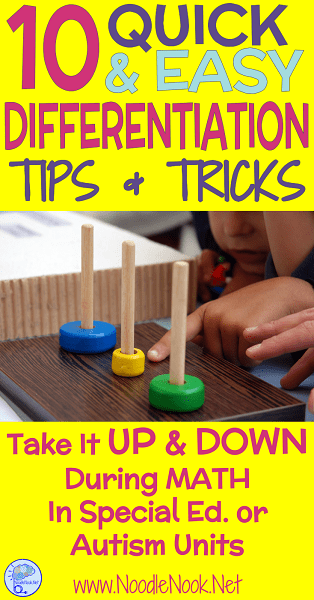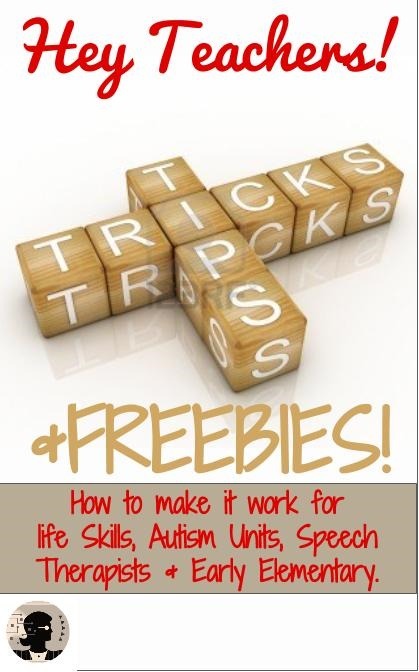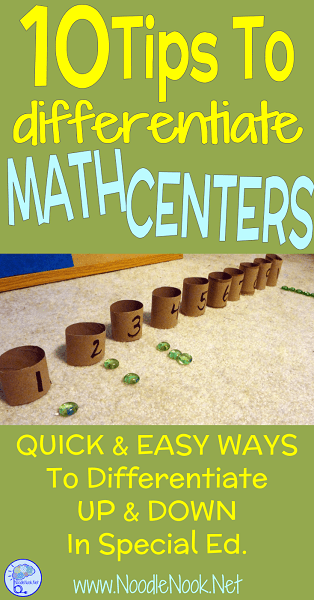Are you finding it hard to differentiate for all your students in a multi-level special education class, Autism unit, or self-contained room? Been there. Here are a few ideas on how to easily and painlessly differentiate math stations with ideas you can apply to other content areas.
Quickly Differentiate Math Stations
Let me guess, you have your stations all set up- today is all about Money Math. You have everything all set and you will be working with students as they come to you to work with some coin task cards.
Most of your students are engaged and learning, but a couple of your students are super-fast and are done in 5-seconds. Then a couple of your students could spend an entire rotation getting their materials or maybe doing nothing at all. Either way, differentiating is just like bowling… if you just roll your ball straight down the middle, then you always miss the pins on the edges (damn that 7-10 split).
So, how do you take a basic activity and differentiate it to make it more meaningful to your students? Let’s walk through an example so you can see differentiation in action!
Start with a Basic Activity
For this example, we are using coin clip cards. I love my readers, so you can get this free 6-pack of coin clip cards from the Summer Monthly Unit below.
This is a great basic station activity for students and it is likely that, just like in my story above, you are throwing a 7-10 split with this one in your class. So let’s talk about how to address this activity with a lower-skilled, mid-leveled, and advanced students.
And, just to clarify, I work with High School students with severe and profound disabilities. I have them all, basic, mid, and advanced leveled students with all kinds of quirks and complexities… and I can teach 15 minutes stations to all those types of students with just the page of 6 task cards for an entire week. No… don’t laugh. I really can. Here’s how:
Differentiating for Basic Students
In a class of students with multiple or complex disabilities, basic students can mean students who have a host of needs or prerequisite deficits that make them unable to complete a task (like coin cards) with minimal support.
- Use Manipulatives. In this example, a student can match coins to the ones on the card. Though there is no actual addition in that skill, I can come back as the teacher and count with them as we remove the coins. With other academic tasks, just the addition of the tactile piece helps. So, to differentiate to basic, think of a way to take it more tactile.
- Choose a Coin! With students who are using alternative modes of communication like a response card, a yes/no visual, or eye gaze, I will present coins one at a time and ask students if it goes on the card. Based on their response, I will place it on the card or put it back in the pile and grab another. Same thing here with other types of activities- figure out ways to make it a single-response activity where you present the stimuli one at a time. This builds a better response mode as well as works on academic skills.
- That’s It! Sometimes we assume a level of skill based on a students disability and response mode. If they have a poor way to communicate, then we assume poor academics… but that can be wrong. With these clip cards and a VOD programmed with a basic phrase like “That’s It!”, you can scroll through the coin card answers one at a time and wait for a student to indicate “That’s It” to mark the right answer. If a student needs a little more support, describe the coins by name or value before presenting the answer choices. With other academic tasks, try scrolling through the options and see if your student can indicate the correct option. You never know!
Differentiating for Mid-Level Students
So usually our mid-level students can do the activity as designed, but even within that group, there are students who are a little more and less skilled. Or, just to add another level, you are looking for a way to expand the task. Here are a few ideas:
4. More or Less. Take two cards and ask a student to decide which one is more or less. This is a challenge for a lot of my students and sometimes requires a number line as a visual aid. Comparing values, amounts, characters, or terms is a great way to take a mid-level activity and expand it. With an ELA activity you may want to classify items by literary terms. This simple way to mix it up makes a basic task all the more.
5. If-Then. What would happen to this amount if I added a quarter, or a nickel, or a dime. What if I took away a penny or other coin (telling the student by coin name or coin value). Being able to manipulate the values with some simple changes can take an activity like the coin cards and expand them.
6. Next Dollar. I love working on and practicing next dollar up in as many scenarios as possible because it feels like a more functional skill that will help in the community. When the amounts are presented on the coin card, I like to ask how much more money it would take to get to the next dollar (here, just to the whole dollar). Now we are working on some subtraction skills, now just addition. I love that added layer. With other academics, think of ways to transfer or generalize the skill.
Differentiating for Advanced Students
There is literally nothing worse than busting your butt to engage the basic students while managing the mid-level students only to look over at your advanced kiddos and see them already finished and looking for mischief. Nothing worse.
7. Multiples. Grab four post-its and label one each with x2, x5, x8, and x10. Now with a student who is burning through a task card, slap this post-it on it. Now this too simple coin adding task just became a differentiated multiples activity. Whoa. So much harder. If you want to push it up a level again, take two cards, each with a different post-it, and then ask the student to find the total. Now they have to remember PEMDAS and multiply before they add. Differentiated it again!
Don’t be afraid, with other content areas, to just bump it up a notch. In English, ask for paragraph s over sentences. Expect definitions, synonyms, and antonyms with vocabulary word work to make any content topic more. That’ll keep them busy and challenged.
8. Discounts. Now grab another 4 post-its and label one each with 10%, 25%, 50%, and 65%. Now, just like above, get a card and put one of these on ‘em. You can see how the activity just became much more challenging. Differentiating win.
9. Add Tax. You’ll only need one post-it for this one… and add your local tax rate on it. Now when you present a coin card, ask students to calculate the tax, add it to the value, and provide a new total. This three step math activity is much more challenging and more suited for those earlier finishers.
You are thinking it right now, aren’t you- “How do I get them to do all that if they don’t know how yet?” Easy peasy, make a graphic organizer for the skill. I have on as part of my Multi-Level Money Math activity and you can get a FREEBIE here: FREE MULTI-LEVEL MONEY MATH
Get yours now, because it works and there is no reason to remake what you can just click and get. You can also get the FULL version here.
10. Pay & Make Change. If you have practice bills in your classroom, grab some and give one to a student along with a card. Ask a student to calculate the change and then count it out. Again, a great way to practice real world skills with a simple task by some easy differentiation.
BONUS: Stack ‘Em! If you really want to make it more for a student who is still blowing through your advanced differentiation, stack numbers 7-10… so, with one clip card, what if you had 6 sets of these coins? Now give 10% of that amount away? Then add 8.25% tax to the new total. Finally make change from twenty dollars. You’ve just done multiplication, division, addition, subtraction and percentages with one little task card. That’s differentiated alright!
10 Ways to Differentiate!
You got it right there- 10 easy ways to differentiate a very easy task card activity. Earlier I said I could teach with one set of 6 task cards in 15 minute stations for a week in my secondary math class and now you can see how. Hopefully this arms you with some ideas on ways to make what you do in your room better meet the needs of your students as you differentiate math stations.
What other activities could you try with a simple coin clip card? Post your ideas in the comments!





